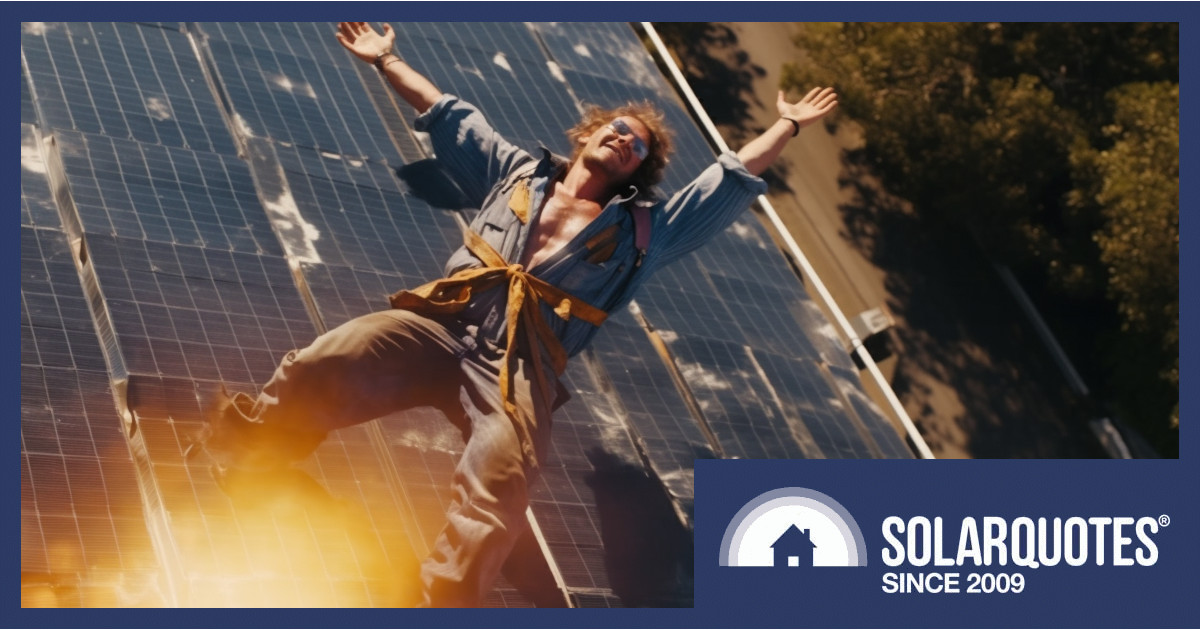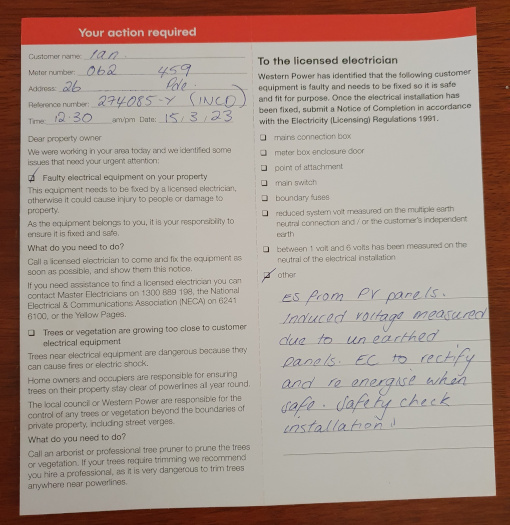
We may have dramatised this image a little.
Safety should always be a top priority when it comes to solar energy installations. Unfortunately, not all solar systems meet the necessary standards, which can lead to some shocking situations. Pun intended.
After fielding a call for help via the technical support service offered at SolarQuotes, we’ll share a real-life incident that underscores the importance of properly earthing solar arrays – in this case using microinverters.
Ian’s Shocking Experience
Picture this: you’re innocently working around your solar array, cleaning gutters or painting a barge cap perhaps. As you lean back to admire your handiwork, you get an unexpected jolt as you touch an aluminium solar mounting rail or panel frame. Yikes!
This incident isn’t hypothetical, or computer-generated like the image above but it left SolarQuotes reader Ian very concerned for his safety and he determined to get to the bottom of what went wrong.
Seeking Expert Advice
In his quest for answers, Ian first sought out the reviews available on the SolarQuotes site for his local area. After some more trawling he came upon Solar Naturally. With a glimmer of hope, he reached out to them, and Solar Naturally didn’t disappoint. They swiftly dispatched an electrician to investigate the system. Lo and behold, the electrician discovered a glaring issue: there was no earthing on any of the arrays! On top of that, they detected a voltage reading between 28V and 82V from the array frames to the ground. This electrician, not entirely familiar with Enphase Micro Inverters or Tesla battery systems, decided to confer with their boss before proceeding.
Confronting the Original Solar Installer
Determined to get some answers, Ian called up the company originally responsible for his system’s installation way back in 2015. Let’s call them ABC123 Solar1. Now, let’s just say ABC123 wasn’t exactly in Ian’s good books due to a protracted and, in the end, unsatisfactory installation experience. When confronted about the lack of earthing, they admitted that, at the time of installation, it wasn’t required. However, they conveniently forgot to mention that regulations had changed shortly thereafter. They promised to dig deeper into the matter and asked for more information and pictures. Not the most comforting response, leaving Ian feeling a bit skeptical about ABC123 Solar’s integrity.
Seeking Assistance from Western Power
Ian told us:
I decided to call the gods at Western Power and to report my mishap involving electricity and my solar system.
Literally 3 minutes after hanging up a tech was on the phone and arranged to be there within the hour. He apologized for being 5 minutes late and then proceeded to do a complete check of the system and indeed the entire house’s electrical system.
Dangerous Induced Voltage From The Microinverters
Not one to back down, our intrepid Ian decided to escalate the matter and contacted his network authority (DNSP) Western Power. And guess what? The technician discovered an 80V AC potential when they tested it against the ground. Turns out, this was an induced voltage was coming from the AC wiring running parallel to the aluminium frame under the panels.

Evidence from Western Power
Unveiling the Truth
Hold onto your hats because here’s where it gets interesting. The technician explained that proper earthing of the solar panel array is crucial for safety. The technician temporarily connected a wire from the problematic rail to the house’s earthing stake.
The technician then consulted with their office and the inspection branch of Western Power to confirm the regulations. Surprise, surprise! There had indeed been a regulatory change, and get this—it was in place before Ian’s system was installed.
Implications for ABC123 Solar
This turn of events doesn’t bode well for ABC123 Solar. At best, they seem incompetent; at worst, they come off as misleading and neglectful of the truth. Western Power didn’t take this lightly and announced plans to scrutinize all similar installations done by ABC123 Solar, which could result in penalties for their failure to adhere to safe practices.
Lessons Learned
Ian engaged Solar Naturally to upgrade his wiring to meet the current standards – ensuring the Enphase-powered solar panels were all safely earthed – a necessary expense amounting to $1,000. And he stressed the importance of spreading awareness about potential hazards in the solar industry. Even the microinverters that some like to market as “fundamentally safe” need to be properly and carefully installed.
We have to say thank you Ian, your experience serves as a vivid reminder of just how crucial it is that solar installers stay up to date with the latest rules and implement them.
Footnotes
- We’ve decided not to name the company so this post can stay up without us wasting time and money arguing with the perpetrators ↩

 RSS - Posts
RSS - Posts



Hi Anthony, I can understand that you do not want to name the company for ethical reasons but on the other hand this are sometimes dodgy installers that are jut trying to make fast money and then sometimes disappear but the customers needs to know who these people are so that we do not use them or support them. I know we should use reputable companies like yours and other to get three quotes from level 3 installers but sometimes it is not that easy.
Thank you Anthony for bringing this to light. Whether you have micro inverters or not it’s been common knowledge in the off grid fraternity for years to earth the solar array for a number of reasons including Joseph’s. If the array is struck by lightning it needs a path to earth rather than through the house which could be fatal to the occupants.
Would it not be possible to claim the rectification works through a small claims tribunal? I would imagine if this was undertaken, the company would want to settle the matter rather than have bad publicity?
I understand why you would “prefer not to waste time arguing” with the original installer if you were to name and shame them, but you have a duty of care to your readers who also would “prefer not to waste time” (or worse) dealing with incompetent installers. That’s just a cop-out by SolarQuotes , and apart from endangering consumers might also expose you to the risk of a crippling lawsuit if your failure to name and shame results in a dangerous incident.
SHAME, GUYS!
I find it unlikely that a voltage was induced from an AC power cable that was strong enough to give someone an electric shock. I believe earthing the panels has now covered up the issue.